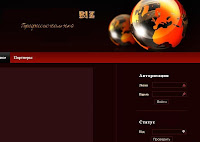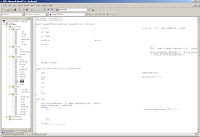
The
Koobface Facebook worm --
go through an
assessment of a previous campaign -- is once again making its rounds across social networking sites,
Facebook in particular. Therefore, shall we spill a big cup of coffee over the malware campaigners efforts for yet another time? But of course.
Only OPSEC-ignorant malware campaigners would leave so much traceable points, in between centralizing the campaign's redirection domains on a single IP. For instance, taking advantage of free web counter whose publicly obtainable statistics -- the account has since been deleted -- allow us to not only measure the clickability of Koobface's campaign, but also, prove that they're actively multitasking by combining blackhat SEO and active spreading across several other social networking sites. Here are some of the key summary points for this campaign :
Key summary points :- the hosting infrastructure for the bogus YouTube site and the actual binary is provided by several thousand dynamically changing malware infected IPs
- all of the malware infected hosts are serving the bogus YouTube site through port 7777
- the very same bogus domains acting as central redirection points from the November's campaign remain active, however, they've switched hosting locations
- if the visitor isn't coming from where she's supposed to be coming, in this case the predefined list of referrers, a single line of "scan ref" is returned with no malicious content displayed
- the campaign can be easily taken care of at least in the short term, but shutting down the centralized redirection points

What follows are the surprises, namely, despite the fact that Koobface is pitched as a Facebook worm, according to their statistics --
go through a previously misconfigured malware campaign stats -- the majority of unique visitors from the December's campaign appear to have been coming from Friendster. As for the exact number of visitors hitting their web counter, counting as of 7 November 2008, 12:58, with 91,109 unique visitors on on 07 Nov, Fri and another 53,260 on 08 Nov, Sat before the counter was deleted, the cached version of their web counter provides a relatively good sample.
On each of the bogus Geocities redirectors, the very same
lostart .info/js/gs.js (58.241.255.37) used in the previous campaign, attempts to redirect to
find-allnot .com/go/fb.php (58.241.255.37) or to
playtable .info/go/fb.php (58.241.255.37), with fb.php doing the referrer checking and redirecting to the botnet hosts magic. Several other well known malware command and control locations are also parked at 58.241.255.37 :
jobusiness .org
a221008 .com
y171108 .com
searchfindand .com
ofsitesearch .com
fashionlineshow .com
anddance .info
firstdance .bizprixisa .comdanceanddisc .comfinditand .comfindsamthing .comfreemarksearch .comfind-allnot .comfind-here-and-now .comfindnameby .comanddance .infoThese domains, with several exeptions, are actively participating in the campaign, with the easiest way to differentiate whether it's a Facebook or Bebo redirection, remaining the descriptive filenames. For instance, fb.php corresponds to Facebook redirections and be.php corresponding to Bebo redirections (
ofsitesearch .com/go/be.php). However, the meat resides within the statistics from their campaign :
 Malware serving URLs part of Koobface worm's December's campaign, based on the identical counter used across all the malicious domains :
Malware serving URLs part of Koobface worm's December's campaign, based on the identical counter used across all the malicious domains :youtube-x-files .com
youtube-go .com
youtube-spy.5x .pl
youtube-files.bo .pl
youtube-media.none .pl
youtube-files.xh .pl
youtube-spy.dz .pl
youtube-files.esite .pl
youtube-spy.bo .pl
youtube-spy.nd .pl
youtube-spy.edj .pl
spy-video.oq .pl
shortclips.bubb .pl
youtubego.cacko .pl
asda345.blogspot .com
uholyejedip556.blogspot .com
ufyaegobeni7878.blogspot .com
uiyneteku20176.blogspot .com
ujoiculehe19984.blogspot .com
uinekojapab29989.blogspot .com
uhocuyhipam13345.blogspot .com
Geocities redirectors participating :geocities .com/madelineeaton10/index.htm
geocities .com/charlievelazquez10/index.htm
geocities .com/raulsheppard18/index.htm
 Sample malware infected hosts used by the redirectors :
Sample malware infected hosts used by the redirectors :92.241.134 .41:7777/?ch=&ea=
89.138.171 .49:7777/?ch=&ea=
92.40.34 .217:7777/?ch=&ea=
79.173.242 .224:7777/?ch=&ea=
122.163.103 .91:7777/?ch=&ea=
217.129.155 .36:7777/?ch=&ea=
84.109.169 .124:7777/?ch=&ea=
91.187.67 .216:7777/?ch=&ea=
84.254.51 .227:7777/?ch=&ea=
190.142.5 .32:7777/?ch=&ea=
190.158.102 .246:7777/?ch=&ea=
201.245.95 .86:7777/?ch=&ea=
78.90.85 .7:7777/?ch=&ea=
82.81.25 .144:7777/?ch=&ea=
78.183.143 .188:7777/?ch=&ea=
89.139.86 .88:7777/?ch=&ea=
85.107.190 .105:7777/?ch=&ea=
84.62.84 .132:7777/?ch=&ea=
78.3.42 .99:7777/?ch=&ea=
92.241.137 .158:7777/?ch=&ea=
77.239.21 .34:7777/?ch=&ea=
41.214.183 .130:7777/?ch=&ea=
90.157.250 .133:7777/dt/?ch=&ea=
89.143.27 .39:7777/?ch=&ea=
91.148.112 .179:7777/?ch=&ea=
94.73.0 .211:7777/?ch=&ea=
124.105 .187.176:7777/?ch=&ea=
77.70.108 .163:7777/?ch=&ea=
190.198.162 .240:7777/?ch=&ea=
89.138.23 .121:7777/?ch=&ea=
190.46.50 .103:7777/?ch=&ea=
80.242.120 .135:7777/?ch=&ea=
94.191.140 .143:7777/?ch=&ea=
210.4.126 .100:7777/?ch=&ea=
87.203.145 .61:7777/?ch=&ea=
94.189.204 .22:7777/?ch=&ea=
92.36.242 .47:7777/?ch=&ea=
77.78.197 .176:7777/?ch=&ea=
94.189.149 .231:7777/?ch=&ea=
89.138.102 .243:7777/?ch=&ea=
94.73.0 .211:7777/?ch=&ea=
79.175.101 .28:7777/?ch=&ea=
78.1.251 .26:7777/?ch=&ea=
201.236.228 .38:7777/?ch=&ea=
85.250.190 .55:7777/?ch=&ea=
211.109.46 .32:7777/?ch=&ea=
91.148.159 .174:7777/?ch=&ea=
87.68.71 .34:7777/?ch=&ea=
85.94.106 .240:7777/?ch=&ea=
195.91.82 .18:7777/?ch=&ea=
85.101.167 .197:7777/?ch=&ea=
193.198.167 .249:7777/?ch=&ea=
94.69.130 .191:7777/?ch=&ea=
79.131.26 .192:7777/?ch=&ea=
190.224.189 .24:7777/?ch=&ea=

119.234.7 .230:7777/?ch=&ea=
199.203.37 .250:7777/?ch=&ea=
89.142.181 .226:7777/?ch=&ea=
84.110.120 .82:7777/?ch=&ea=
119.234.7 .230:7777/?ch=&ea=
84.110.253 .163:7777/?ch=&ea=
82.81.163 .40:7777/?ch=&ea=
79.179.249 .218:7777/?ch=&ea=
190.224.189 .24:7777/?ch=&ea=
79.179.249 .218:7777/?ch=&ea=
87.239.160 .132:7777/?ch=&ea=
79.113.8 .107:7777/?ch=&ea=
81.18.54 .6:7777/?ch=&ea=
118.169 .173.101:7777/?ch=&ea=
85.216.158 .209:7777/?ch=&ea=
219.92.170 .4:7777/?ch=&ea=
79.130.252 .204:7777/?ch=&ea=
93.136.53 .239:7777/?ch=&ea=
62.0.134 .79:7777/?ch=&ea=
79.138.184 .253:7777/?ch=&ea=
173.16.68 .18:7777/?ch=&ea=
190.155.56 .212:7777/?ch=&ea=
190.20.68 .136:7777/?ch=&ea=
119.235.96 .173:7777/?ch=&ea=
77.127.81 .103:7777/?ch=&ea=
190.132.155 .122:7777/?ch=&ea=
89.138.177 .91:7777/?ch=&ea=
79.178.111 .25:7777/?ch=&ea=
84.109.1 .15:7777/?ch=&ea=
89.0.157. 1:7777/?ch=&ea=
122.53.176 .43:7777/?ch=&ea=
200.77.63 .190:7777/?ch=&ea=
67.225.102 .105:7777/?ch=&ea=
119.94.171 .114:7777/?ch=&ea=
125.212.94 .80:7777/?ch=&ea=
Detection rate for the binary, identical across all infected hosts participating :flash_update.exe (Win32/Koobface!generic; Win32.Worm.Koobface.W)
Detection rate : 28/38 (73.69%)
File size: 27136 bytes
MD5...: 3071f71fc14ba590ca73801e19e8f66d
SHA1..: 2f80a5b2575c788de1d94ed1e8005003f1ca004d
Koobface's social networks spreading model isn't going away, but it's domains definitely are.
Related posts:Dissecting the Latest Koobface Facebook CampaignFake YouTube Site Serving Flash ExploitsFacebook Malware Campaigns Rotating TacticsPhishing Campaign Spreading Across FacebookLarge Scale MySpace Phishing Attack
Update on the MySpace Phishing Campaign
MySpace Phishers Now Targeting Facebook
MySpace Hosting MySpace Phishing Profiles
 In one of those "better late than never" type of situations, last month members of the Global Islamic Media Front were busted in Germany. The group is largely known due to their releases and propaganda of the Technical Mujahid E-zine (Part Two) and the Mujahideen Secrets encryption tool (Second Version). GIMF was distributing its multimedia through popular Web 2.0 video sharing sites, perfectly fitting into the profile of the majority of cyber jihadist groups.
In one of those "better late than never" type of situations, last month members of the Global Islamic Media Front were busted in Germany. The group is largely known due to their releases and propaganda of the Technical Mujahid E-zine (Part Two) and the Mujahideen Secrets encryption tool (Second Version). GIMF was distributing its multimedia through popular Web 2.0 video sharing sites, perfectly fitting into the profile of the majority of cyber jihadist groups.









































